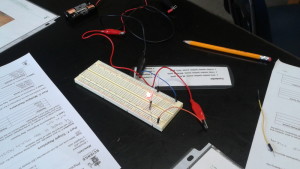Resistance is not futile!
Today the scientists taught the class about Ohm’s Law, a fundamental relationship in electronics and circuitry. Georg Ohm was a German physicist in the 19th century who first discovered that voltage is directly proportional to both current and resistance or V=IR. Voltage is what pushes the electrons along through the circuit, and resistance is a property that resists the flow of electrons. So this equation is saying that the harder you push on the electrons (increase voltage), the faster they go (increased current). Alternatively, if you increase the resistance to the current, the voltage must therefore also drop.
For the activity, we built real circuits on breadboards and used them to light up red LEDs. We then experimented with resistors, and added them to the circuit in series (in a row) and in parallel (next to each other). We discovered that adding a resistor in series increases the total resistance of the circuit, but if we add a resistor in parallel, the total resistance actually decreases! Ask your student to explain why that is!





Leave a Reply